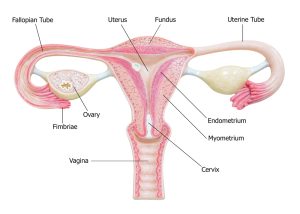The female cervix refers to the lower, narrow end of the uterus that forms a canal between the uterus and the vagina. It’s a passage that allows fluid to flow inside and out of the uterus, which makes pregnancy and childbirth possible.
Despite the lack of public awareness, cervical cancer marks the 4th most common cancer in women. In 2018, an estimated 570 thousand women were diagnosed with cervical cancer worldwide and about 311 thousand women died from the disease. To aid the public health campaign against cervical cancer, the United States Congress designated January as Cervical Health Awareness Month.

Common cervical complaints
There are many cervical conditions that may be able to cause the following common complaints:
- Abnormal vaginal bleeding: irregular vaginal bleeding, heavy, irregular menstrual bleeding, and/or bleeding after sexual intercourse.
- Abnormal vaginal discharge: blood-stained or purulent malodorous discharge. The discharge can be cloudy, red, green, or yellow in colour.
- Pain occurs during or after sexual intercourse
- Pelvic pain without trauma
If you have any one of the above symptoms, make an appointment with your doctor immediately. Early treatment and intervention for cervical conditions can cure the cause in most circumstances.
Causes of cervical symptoms
-
Cervical cancer
The most important cause not to be missed when making a diagnosis is cervical cancer. It begins when healthy cells in the cervix begin to replicate in an uncontrolled fashion. The accumulating abnormal cells form a mass, also known as a tumour. The abnormal cells might invade nearby tissues and can break off from the tumour to spread elsewhere in the body, potentially causing liver, lung, and bone cancer.
Despite the fact that cancer always sounds scary, the 5-year survival rate is 92% if diagnosed at an early stage without spreading. It’s one of the most successfully treatable forms of cancer. Even if diagnosed at a later stage, it can still be controlled with appropriate treatment and palliative care.
Scientists still don’t know what exactly triggers cervical cancer, but Human papillomavirus (HPV) infection significantly contributes to the incidence of cervical cancer. However, it’s important to know that most people with the infection do not eventually develop cervical cancer. The HPV vaccine is now available in most regions and works effectively in preventing HPV infection. It’s usually recommended at age 11 or 12 years for both men and women.
-
Sexually Transmitted Infections (STIs)
Common sources of STIs include gonorrhoea, chlamydia, trichomoniasis, and genital herpes. They present similarly to cervical cancer, and most commonly occur among young sexually active individuals. To prevent STIs, practice safe protected sex, and consult your doctors for regular check-ups if you are having new sexual partners or having multiple sexual partners at the same time.
-
Allergic reactions
Some people might develop an allergic reaction to feminine hygiene products or the latex in condoms. Patients usually complain of mild itchiness around the vagina opening and may appear inflamed. Avoiding contact with causative products usually stops the symptoms.
What to expect when visiting a doctor
If you have any of the symptoms mentioned above, the doctor will first take a thorough history of your symptoms and may or may not include your sexual history. Let the doctor know if you are uncomfortable discussing this. For examination, your doctor will insert one or two lubricated, gloved fingers into the vagina and press on the lower abdomen with the other hand. This is done to check the size, shape, and contour of a female’s reproductive organs. In addition, a speculum may be inserted into the vagina to widen it so that your doctor can collect sample cells from the cervix for lab analysis. The analysis is known as a pap test, which takes a few days to complete, and is very acute in identifying potential cancerous cells or sources of infection.
Conclusion
Cervical conditions, including cervical cancer, are not hard to treat. We have the technical, medical and policy tools to eliminate them altogether. In some societies in Asia, cervical conditions remain taboo among the common folks. This does not help our effort to counter the prevalence of cervical cancer. To read more on public health campaigns and what you can do to help raise awareness, click here.













